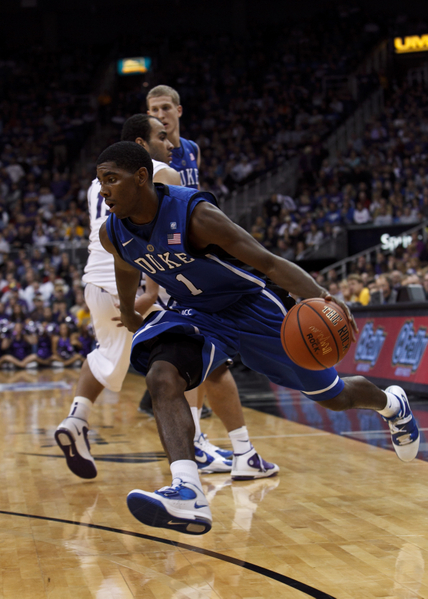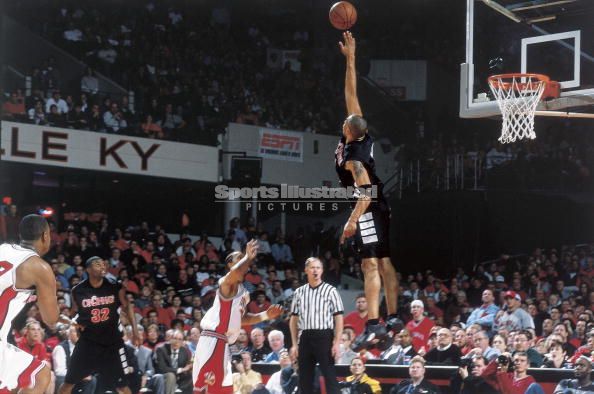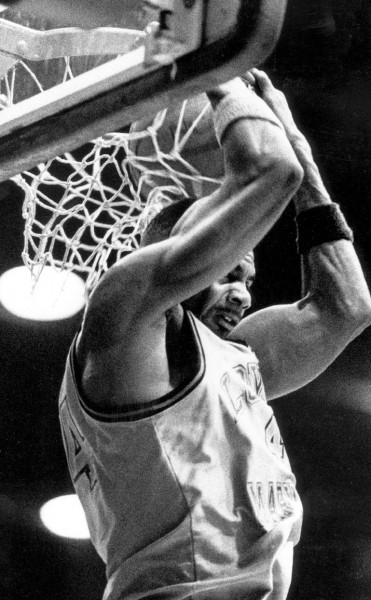Past Imperfect: Major Losses, Mixed Results
Posted by JWeill on January 20th, 2011Past Imperfect is a new series focusing on the history of the game. Every Thursday, RTC contributor JL Weill (@AgonicaBoss) highlights some piece of historical arcana that may (or may not) be relevant to today’s college basketball landscape. This week: How teams over college basketball history have dealt with seemingly devastating injuries to star players. The answer? It depends …
When freshman Duke point guard Kyrie Irving came down awkwardly in a game against Butler with what was a then-seemingly innocuous injury to his toe, the entire landscape of this college hoops season was altered, perhaps irrevocably. Up to that point, there was little disputing who was the 2010-11 college basketball favorite. Not only was Duke the defending NCAA champion, it also returned most of the firepower from that title-winning side as well as adding the nation’s top point guard prospect in New Jersey’s Irving, at a position that was previously the only real soft spot on the Blue Devils roster. With Irving out indefinitely, gone was the swagger of invincibility Duke had in droves in the early weeks of the season. Gone, too, was the sheer talent and ability of Irving, who had earned his accolades and then some with his performance in the season’s first eight games. Irving had saved Duke with 31 points in a win over Michigan State at Cameron Indoor and had reached double figures in points in all of his few games as a collegian. Of course, Purdue would have gladly taken even eight games from its star, Robbie Hummel. Already rehabbing a rebuilt knee from an injury last season, Hummel lasted all of a practice and a half before coming down in a heap after blowing out the same knee. A trendy preseason Final Four pick, Purdue was left without its senior leader and second-leading returning scorer before the season had really even begun.
It remains to be seen whether Duke will shake off the likely loss of Irving’s freshman season and make a run to a second straight title or whether Purdue can find among the guys remaining the makings of a Final Four contender. Both teams have talent on the roster, if not replacements exactly. Teams in the situation Duke and Purdue find themselves in have historically had mixed results recovering. For every championship-caliber team to overcome a major personnel loss to injury there is one for whom the absence of a star player was devastating to its long-term NCAA hopes. Much of that, it turns out upon review, is related to the timing of the injury, as well as just how crucial a role the injured player played on his team. For some squads, losing a player at midseason turned out to be, while never preferred, preferable to losing him just before or during March. For others, losing an on-court presence isn’t as much an issue as losing the club’s emotional leader.
In February of 1997, Rick Pitino’s defending national champion Kentucky Wildcats were ranked fifth in the nation, riding the stellar play of dynamic scoring wings Ron Mercer and Derek Anderson to a 15-2 record heading into a seemingly innocuous game against an overmatched Auburn team at Rupp Arena. At the time, Mercer and Anderson were the most explosive 1-2 combination in America. Then, during the game, Anderson twisted his knee awkwardly on a break and tore his ACL, effectively ending his career as a Wildcat. “It’s like it’s October 15 again as far as our offensive execution is concerned,” Pitino said a few weeks later. But partly because of roster depth and partly because they had time to work around Anderson’s absence, the Wildcats regrouped and managed only three more losses the rest of the season, the final one coming in a classic overtime NCAA championship game vs. Arizona. Anderson returned for just one brief moment, sinking a pair of free throws in zero minutes played in a Final Four win over Minnesota. Kentucky fans still maintain that had Pitino played Anderson even a few minutes in the final, the Wildcats would have taken the title.
Unlike that Kentucky team, in 1980, Iowa got its injured star back right at tournament time. It was nearly enough to take them to unmatched glory. That season’s edition of the Hawkeyes was arguably the best in school history. Led by All-American Ronnie Lester, Iowa rolled to a 7-0 record and a spot in the top 10 before Lester injured a knee against Dayton. Without their star, a more balanced, if less explosive, Hawkeyes still managed 19 regular season wins and a No. 5 seed in the NCAA Tournament. Lester returned to the lineup in the regular season finale, and, with its star returning to form, Iowa reeled off four wins in the NCAAs to make what is to date the school’s last Final Four appearance. Again proving his worth, in the semifinals against eventual champion Louisville, Lester reinjured his knee and without him for most of the game Iowa succumbed to the Cardinals by eight points.
Not every team has been so resilient, of course.
The 1984 edition of the North Carolina Tar Heels proved unable to recover from losing freshman point guard Kenny Smith to a broken wrist. After 17 games, UNC was undefeated and beating opponents mercilessly. Smith had done a great job of what he was there to do: pass the ball to some guys named Jordan, Daugherty and Perkins. While, like Iowa’s Lester, Smith returned just before tournament time, and North Carolina finished the regular season a No. 1 seed with 26 wins, the team was never the same as it had been before his injury. And Smith was clearly hampered by the time off. Despite the presence of those All-American players, it was that skinny freshman point guard who proved irreplaceable, as North Carolina fell in the Sweet 16 to Indiana.
The problem of losing key players right before or during the NCAA tournament is a wholly different one. Without the remaining regular season games to work around losing a critical player to injury, and without time for him to return, with few exceptions, nearly every one of these teams spends hoops eternity asking ‘What if…’
First and foremost on this list is the 1999-2000 Cincinnati Bearcats. Bob Huggins’ best chance at a national title in Cincinnati effectively ended when consensus national Player of the Year Kenyon Martin suffered a broken leg in the Conference USA tournament quarterfinals. Previously considered the odds-on favorite to win it all, less than two weeks later, Cincinnati was headed home after an upset loss to Tulsa in the second round of the NCAAs. Martin’s injury was the worst kind for a team on a roll: not just debilitating, but deflating. When it’s star and emotional leader was lost, the team lost its mojo as well. Perhaps Huggins himself said it best later: “You have very few chances in life to be special. This was their chance.”
On the verge of doing something so special that few teams have ever managed it, the 1974-75 Indiana Hoosiers entered the NCAA tournament undefeated. With a disciplined, talented and balanced roster, Indiana had all the pieces it needed to win coach Bob Knight’s first title. Then starting forward Scott May broke his arm against Purdue in late February and was effectively done for the year. Indiana still rallied to within a bucket of the Final Four, losing in a classic to Kentucky in the Elite Eight. But when the same roster – May included – returned to go undefeated and win the championship a season later – the last team to finish a year unblemished – Hoosier fans were left forever pondering the true significance of May’s injury. Most believe back-to-back undefeated campaigns was not out of the question.
But while most teams haven’t been able to overcome star injuries late in the season, there have been a few occasions where the loss of a prominent player has actually galvanized a team to over-perform.
Witness last season’s surprise Final Four run by a Michigan State team suddenly forced to play without its starting point guard, Kalin Lucas. The Big Ten Player of the Year the season before, Lucas suffered a torn Achilles in the second round against Maryland. After rallying to win on a late three-pointer by his replacement, Korie Lucious, Michigan State leaned on its punishing defense and rebounding and managed a Final Four run with its floor leader watching in a protective boot from the bench. This was a case where, despite the odds, coaching and guts helped a team weather the loss of its star performer.
And then there is the case of Hank Gathers. Gathers was the nation’s scoring and rebounding leader in 1990, the centerpiece of Loyola Marymount’s run-and-gun attack. Big, strong and fearless, Gathers was a star on the rise when tragedy struck. Just days before the announcement of that season’s NCAA brackets, Gathers collapsed in a quarterfinal game of the West Coast Conference Tournament and died, the victim of an unknown heart condition. His teammates, still reeling from the loss of their teammate and friend, found a particularly impressive way to honor Gathers, their fallen comrade. After being dropped to a No. 11 seed by the NCAA Selection Committee, LMU trounced New Mexico State and Michigan before squeaking past Alabama to reach the Elite Eight. Despite falling to eventual champion UNLV a game short of the Final Four, the Lions’ emotional response to the loss of Gathers captured the nation’s attention and nearly pushed Loyola Marymount into the Final Four.
They also showed that while it may be difficult, losing a star player unexpectedly can be overcome, though generally it helps to have time to regroup. While Kyrie Irving and Robbie Hummel’s injuries are nothing akin to what befell Hank Gathers — not even close — their importance to their teams is still significant. Whether Duke and Purdue can still reach the final weekend of the NCAA tournament remains to be seen. If history is any guide, it’s all up to them.













































